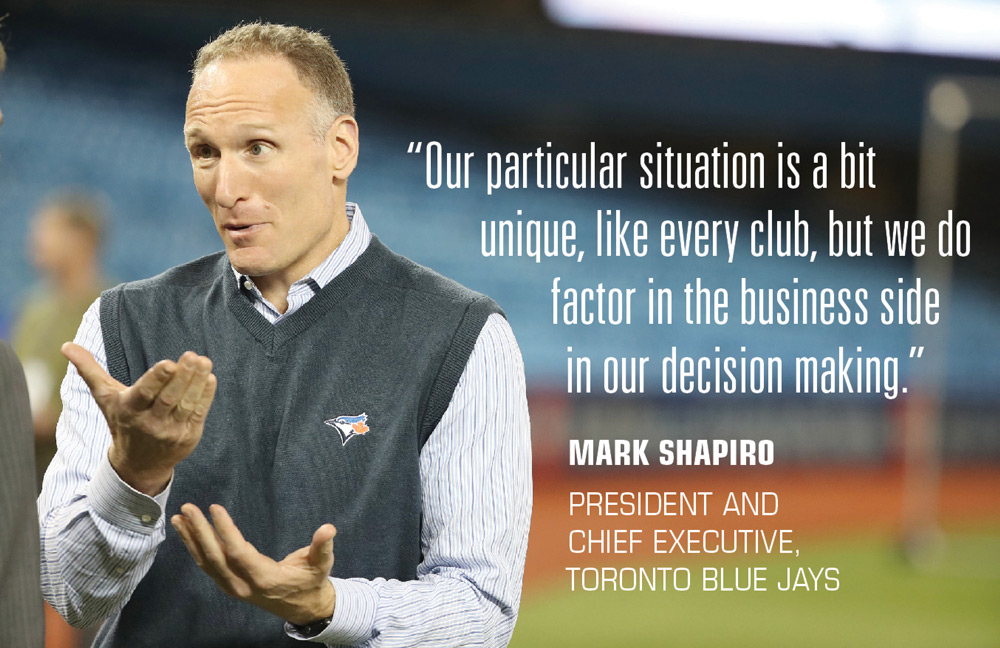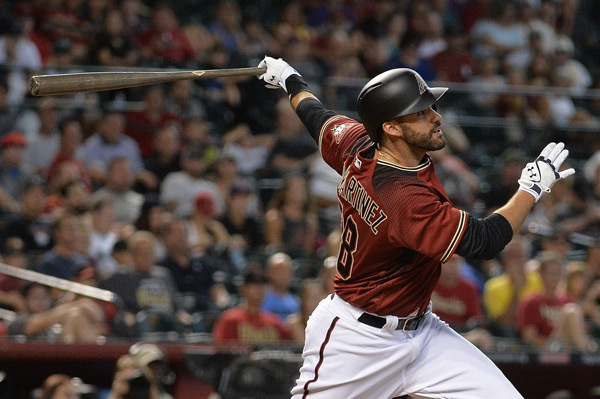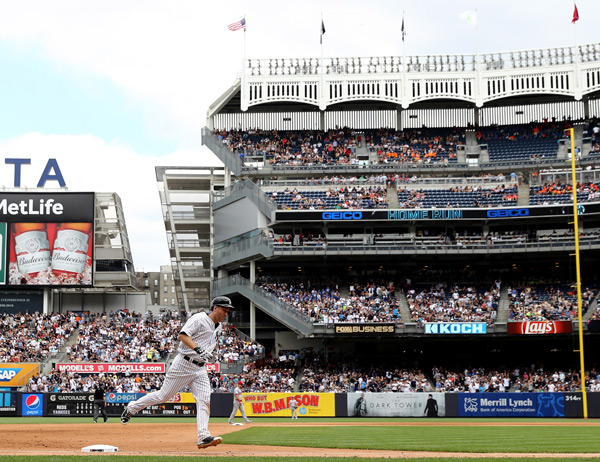 |
| GETTY IMAGES |
Toronto Blue Jays President and Chief Executive Officer Mark Shapiro knows he has a dilemma.
Shapiro’s club, a playoff team the last two years, has underachieved all season and spent nearly all of 2017 in the American League East basement. On the surface, that would make his veteran-laden club a prime candidate to be a seller at Major League Baseball’s July 31 non-waiver trade deadline and begin a rebuilding process centered on younger, lesser-known talent.
But as the AL’s top attendance draw and an emerging business powerhouse in the sport, Shapiro knows it’s not nearly that simple for the Blue Jays. Earlier this month, Shapiro said trading away marquee players would be a “violent disruption” to the franchise, and as the trade deadline approached, he still found it difficult to think of Toronto as purely a seller.
“We are obviously aware of the objective reality of the standings. But at the same time, we owe it to our fans to try and contend as long as we possibly can,” Shapiro said. “And given our roster and the type of talent we already have, we believe we could be having a very different conversation a year from now.”
Shapiro’s trade deadline struggles typify the often-difficult balance between baseball and business at this point in the calendar. The non-waiver trade deadline represents a key avenue for any team to acquire talent and shape its roster. A successful trade deadline haul, such as what the New York Yankees did last year to acquire outfielder Clint Frazier, reliever Adam Warren and a collection of highly touted prospects, can significantly alter the trajectory of a team on and off the field, while a failure to act effectively can damage a club’s development.
But given the trade deadline also occurs in the heart of the season, contrary to the opening of free agency, and right when many teams are planning for not only postseason games but also season-ticket and sponsorship renewals for the following year, fan reaction is never far from the thought processes of baseball operations.
“Fans are typically more focused on the short term than we are,” Shapiro said.
First Look podcast, with MLB trade deadline discussion at the 20:55 mark:
There is no specific, defined estimate for what trading away a star like outfielder Jose Bautista or third baseman Josh Donaldson could mean in revenue loss for Toronto. But the Blue Jays drew 3.3 million to Rogers Centre in 2016, the club’s highest mark in 23 years and reversing a long run as one of the sport’s more mediocre clubs at the gate. The club also had franchise-record local TV ratings. Those bullish metrics have remained strong this year, even with the Blue Jays’ sub-.500 level play all season, and there is little appetite among club executives for a marked retreat.
“Our particular situation is a bit unique, like every club, but we do factor in the business side in our decision making, and our level of fan support has been nothing short of exceptional,” Shapiro said.
Even the Oakland A’s, unlike Toronto a clear seller at the trade deadline, are trying to balance short-term and long-term business considerations. A recent A’s trade with Washington brought in a pair of prospects in exchange for popular relievers Sean Doolittle and Ryan Madson, and as of last week, Oakland starting pitcher Sonny Gray was a prime figure on the trade block.
 |
Diamondbacks acquired J.D. Martinez from the Tigers.
GETTY IMAGES |
A’s President Dave Kaval, like most of his business-side contemporaries, isn’t actually in the room with baseball operations evaluating trade offers. But his input and influence isn’t far away, either. He’s still trying to keep fans engaged and rallied around a heightened organizational focus on the team’s roots in Oakland while executive vice president of baseball operations Billy Beane and his staff retool the roster. Later this year, the A’s also are expected to announce the location and timetable for a new stadium to replace Oakland-Alameda County Coliseum.
“Our overarching goal is to develop a young nucleus of talent that we can take into the new ballpark,” Kaval said. “To have baseball and business really aligned along that long-term strategy and not be year-to-year, that’s a new thing for us. We’ve taken that unified message to our fans, and we believe there’s a positive vibe around what we’re doing.”
Business metrics have also informed the Arizona Diamondbacks’ trade activities this month. Improved attendance, particularly in the last two months, along with resurgent play gave owner Ken Kendrick the confidence to take on $5 million in additional salary in a trade with Detroit for outfielder J.D. Martinez. Immediately after the Martinez trade, the Diamondbacks drew nearly 110,000 for a weekend series against Washington, more than 40 percent above Arizona’s attendance average so far this season and more than a third higher than the club’s previous weekend home slate.
Arizona is developing a four-game mini-ticket plan to help lift crowds further in the season’s homestretch. And with additional attendance gains, it’s quite possible that most, if not all, of the Martinez salary soon will be covered by incremental revenue.
“We’re doing well, and we’re ahead of budget projections, and that definitely helped allow J.D. to come here,” said Diamondbacks President Derrick Hall. “But making that deal also has its own reward beyond just having the player. We showed the fans we care and we believe in this team, and that’s marketing in and of itself.”
 |
Todd Frazier homered for the first time since joining the Yankees.
GETTY IMAGES |
Several emerging factors have made the trade deadline an even larger and more important presence within the sport. A marked preference for younger talent still under long-term team control has swept through baseball in recent years, leaving many franchises less enticed with spending top-market dollars for veteran free agents. And thanks to extensive media coverage of Minor League Baseball, the MiLB.TV live streaming platform and social media, fans are now more aware of prospects than ever.
“Fans absolutely know who all our top prospects are,” said Brooks Boyer, Chicago White Sox senior vice president of sales and marketing. “Before, you would make a trade for prospects, and the fans would say, ‘Who?’ But now you have something like a video of [recently acquired White Sox prospect] Eloy Jimenez blowing out a light tower in a minor league Home Run Derby like in ‘The Natural,’ and it immediately goes viral.”
The White Sox are undergoing a large-scale rebuilding that dates to last winter and this month parted with front-line players such as starting pitcher Jose Quintana, closer David Robertson and third baseman Todd Frazier in trades with the crosstown Chicago Cubs and the Yankees. Rather than see a flight at the turnstiles and TV metrics as the on-field losses have mounted following the trades, the club was widely applauded for the deals.
And the young players coming to the White Sox will now form a major part of the club’s marketing and promotion going forward.
The key to getting White Sox fans to buy into that long-term vision, Boyer said, is a complete level of transparency and candor about what they are doing.
“We haven’t been cute about anything. We’ve laid absolutely everything out for everybody to understand,” Boyer said. “We’re stockpiling our assets. That’s our story in the market, and our fans are seeing that play out. And what’s happened now at the deadline is that our fans have gotten a little trade fever, and now they’re asking who else we’re going to get.”
A primary influence for that level of honesty isn’t that far from Boyer and the White Sox as the Cubs similarly went through a large-scale and very public rebuilding en route to the 2016 World Series title, buttressed in part by a key trade deadline deal last year for closer Aroldis Chapman.
While Oakland, the White Sox and others are looking to the future at the trade deadline, Kansas City is still looking at the present. After a terrible start to the 2017 season, both on and off the field, the Royals this month have surged back into the playoff race. A trade last week with San Diego yielded three major league pitchers, with owner David Glass wanting to make another playoff push before much of the club’s nucleus hits free agency this offseason. And like Toronto, business metrics such as the team’s league-leading TV metrics were part of the Royals’ trade evaluation process.
“This absolutely sends a message to the market that we’re committed, and our fan support has been fantastic,” said Mike Bucek, Royals vice president of marketing and business development. “Clearly, ownership and baseball operations are trying to have a competitive team, and it’s helped build that feeling that we’re all in this together.”






